|
U.S. Naval Aviation In the South Pacific during WW II Featuring the Lexington Aircraft Carrier The Battle of the Marianas — June 1944 Chapter 1 Page 1 of 7 Pages |
||||||||||||
| The early months of 1942 were tumultuous times for the United States as our government struggled to reorganize and refocus efforts to deal with threats in both the Atlantic and Pacific theaters of war. Fresh disasters plagued the U.S. forces as the Japanese advanced south, east and west in the Pacific. They had taken a great gamble in spreading their forces so thin but they had, up to this point, held a winning hand. Now they had to consolidate their victory by sealing off Australia, and finish destroying the U.S. Pacific Fleet.
Their first targets were Port Moresby in New Guinea and Tulagi in the Solomons to establish bases for command of the Coral Sea and the East coast of Australia. In the fighting during the first days of May 1942 in the Coral Sea the Japanese thrust was blunted and turned. A month later, off Midway, the western outpost of our Hawaiian defenses, the U.S. Navy really gave Admiral Yamamoto a beating. The Japanese suffered losses of carriers and planes which they were never able to make up. In consequence the landings in the Aleutians proved to be a barren victory. With Australia and Port Moresby safeguarded, a firm ground was assured from which MacArthur’s army could start its long climb back through jungle-clad islands to the Philippines. From Midway on, though there were difficult and bloody months ahead, the offensive belonged to the U.S. in the Pacific. |
||||||||||||
| The Coral Sea engagement was the first naval battle in which no surface ship engaged another. It was also the opening phase of the Japanese warlords’ ambitious expansion of their original program. Finding conquest tasty, they decided to have some more. Phase 1 (Operation Mo) called for capture of Port Moresby on the New Guinea side of the Coral Sea, and Tulagi, the Solomons’capital, on the east. Phase 2, the capture of Midway and the western Aleutians, was Admiral Yamamoto’s special project for annihilating the U.S. fleet. Phase 3 entailed seizure of New Caledonia, Fiji and Samoa, to cut the lifeline to Australia (whose invasion was never intended). Yamamoto’s greatest trouble was that the Allies had been breaking his code. When, in April of 1942, Japan’s vice Admiral S. Inouye began moving his forces south into the Coral Sea, Admiral Nimitz already knew the U.S. navy would have to fight the Battle of Midway a month later. He decided to make a stand at both places. Nimitz ordered Admiral Fletcher to Tulagi. On May 7 Vice Admiral T. Takagi’s carrier force found the destroyer Sims and the tanker Neosho, and sank both. Fletcher’s fliers spotted the 12,000-ton light carrier Shoho and sent it under. Still the principal forces had not met. But next day war birds from the giants — Zuikaku and Shokaku (30,000 tons each) vs. Lexington (33,000) and Yorktown (20,000) — attacked each others’ nests simultaneously. Three SBD Navy dive bombers damaged Shokaku so badly she couldn’t go to Midway; Zuikaku lost so many planes she stayed out too. Both U.S. carriers were hit -the old Lexington fatally. The Japanese had outscored the Americans, but Admiral Takagi reviewed his losses and turned back. Vital Port Moresby was saved. |
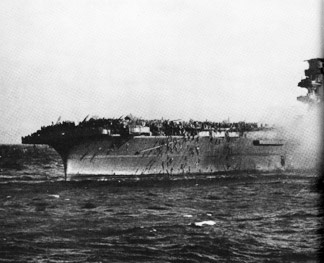 |
|||||||||||
|
Below: The “Lexington” survived torpedo hits but an hour later suffered a fatal series of explosions when gasoline vapor ignited between decks. When “Lady Lex” went down her survivors wept. |
||||||||||||
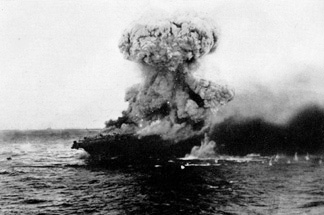 |
||||||||||||
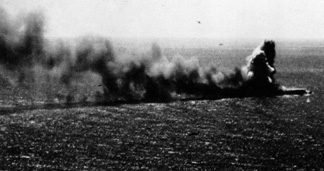 |
||||||||||||
|
These photos ctsy. of LPHOWWII. |
||||||||||||
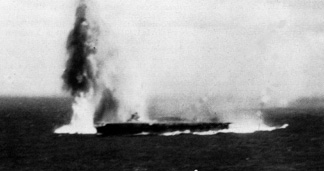 |
||||||||||||
| Life correspondent Noel F. Busch and photographer J. R. Eyerman were on the job aboard the Task Force 58 flagship in the month of June 1944. Their reporting, relating to the Battle of the Marianas, the primary focus of this presentation, is recorded in the July 17, 1944 issue of Life Magazine. The chronology of events outlined in this section will take excerpts from their reports, as well as connective data that was gleaned from the Time Inc. “Life’s Picture History of World War II” and from the USS Lexington CV-16 web site resources. Busch’s journal of this battle runs from June 7 through June 22, 1944. The cruise of Admiral Mitcher’s Task Force 58 - the greatest carrier task force in naval history - started from an advance Pacific base, bound for Saipan, a 52- square-mile island southeast of Tokyo. There, in conjunction with the main body of Admiral Raymond Spruances’ Fifth Fleet, Mitcher’s planes and ships supported the Marine and Army landings. A few days later one of the three striking groups within Task Force 58, including Mitcher’s flagship, moved south to Guam. There it eventually became engaged in the great air battle of June 19. Next day Mitcher’s planes found the Japanese carrier force and the Battle of the Eastern Philippines ensued. |
||||||||||||
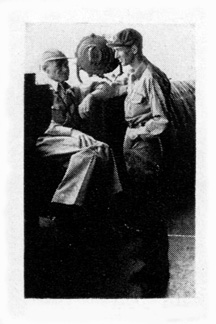 |
||||||||||||
|
Ctsy: Life Mag., dated 6/17/44 |
||||||||||||
| Editor’s notes:
1) There have been five United States ships named USS Lexington. The carrier Lexington referred to here, was number four. The Lexington that is featured in the remainder of this story is Lexington number five. 2) Now that you know what happened to the USS Lexington # 4, the story moves forward approximately two years where the battle of the Pacific has continued unabated. |
||||||||||||
|
June 7, 1944: The U.S. battle fleet of several hundred assorted warships, all under command of Admiral Raymond A. Spruance, is divided into two parts: the invasion force, composed of battleships, cruisers, destroyers and troop transports containing marines and soldiers, and the fast carrier task force, known as Task Force 58, under Mitscher. It is D-day minus 8 and Task Force 58 moves westward. |
||||||||||||
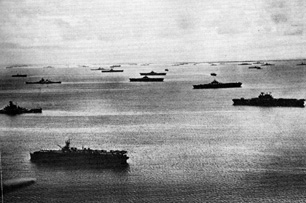 |
||||||||||||
|
|
||||||||||||
|
Chapter 1— End of Page 1 of 7 Pages — Go to Page 2 Page —1 — 2 — 3 — 4 — 5 — 6 — 7 Or This Story’s Cover Page — Editor’s Introduction — Table of Contents Fred Gwynn’s “Torpedo 16” — Chapter — 1 — 2 — 3 — 4 Or Home - Contact Us - Cold War Hist. - 91st SRS Hist. - Stardust 40 Mission Story |
||||||||||||